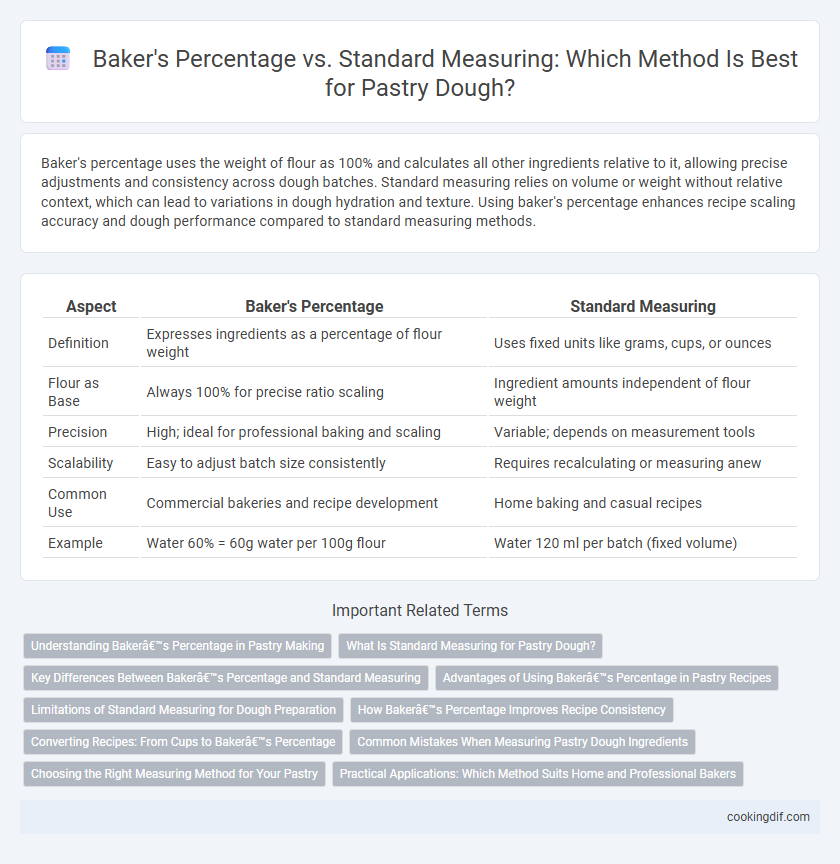Baker's percentage uses the weight of flour as 100% and calculates all other ingredients relative to it, allowing precise adjustments and consistency across dough batches. Standard measuring relies on volume or weight without relative context, which can lead to variations in dough hydration and texture. Using baker's percentage enhances recipe scaling accuracy and dough performance compared to standard measuring methods.
Table of Comparison
| Aspect | Baker's Percentage | Standard Measuring |
|---|---|---|
| Definition | Expresses ingredients as a percentage of flour weight | Uses fixed units like grams, cups, or ounces |
| Flour as Base | Always 100% for precise ratio scaling | Ingredient amounts independent of flour weight |
| Precision | High; ideal for professional baking and scaling | Variable; depends on measurement tools |
| Scalability | Easy to adjust batch size consistently | Requires recalculating or measuring anew |
| Common Use | Commercial bakeries and recipe development | Home baking and casual recipes |
| Example | Water 60% = 60g water per 100g flour | Water 120 ml per batch (fixed volume) |
Understanding Baker’s Percentage in Pastry Making
Baker's percentage in pastry making calculates ingredients based on the flour weight as 100%, allowing precise scaling and consistency in dough recipes. This system enhances accuracy by expressing each ingredient's proportion relative to flour, improving dough texture and baking outcomes. Unlike standard measuring methods that rely on volume or weight alone, baker's percentage ensures reproducible results across different batch sizes.
What Is Standard Measuring for Pastry Dough?
Standard measuring for pastry dough uses fixed quantities of ingredients such as cups, tablespoons, or grams, providing straightforward, easy-to-follow recipes ideal for home bakers. This method emphasizes precise volume or weight measurements without regard to the total flour weight, ensuring consistency in texture and flavor for standard-sized batches. Unlike baker's percentage, which calculates ingredient ratios based on flour weight to optimize dough performance, standard measuring prioritizes simplicity and accessibility in pastry preparation.
Key Differences Between Baker’s Percentage and Standard Measuring
Baker's percentage expresses each ingredient as a proportion of the flour weight, enabling scalable and consistent dough formulation regardless of batch size. Standard measuring uses fixed units like grams, cups, or ounces, which can lead to inconsistencies when scaling recipes or substituting ingredients. The key difference lies in baker's percentage facilitating precise adjustments and comparisons in professional baking, while standard measuring suits basic home applications.
Advantages of Using Baker’s Percentage in Pastry Recipes
Baker's percentage offers precise ingredient scaling based on flour weight, ensuring consistent dough texture and quality in pastry recipes. It simplifies recipe adjustments for different batch sizes, minimizing errors associated with volume measurements. This method enhances control over hydration levels, crucial for achieving optimal dough elasticity and flaky pastry layers.
Limitations of Standard Measuring for Dough Preparation
Standard measuring for dough preparation often leads to inconsistent results due to variations in ingredient weight and moisture content, impacting dough texture and rising. Baker's percentage provides precise proportional relationships based on flour weight, ensuring reproducibility across batches and ingredient substitutions. Relying solely on standard volume measurements can cause inaccuracies, especially in recipes requiring precise hydration levels for optimal pastry quality.
How Baker’s Percentage Improves Recipe Consistency
Baker's percentage improves recipe consistency by expressing each ingredient as a percentage of the flour weight, allowing for precise scaling regardless of batch size. This method ensures uniform hydration, fermentation, and texture by maintaining proportional ingredient ratios. Unlike standard measuring, baker's percentage minimizes variations caused by volume or weight differences, leading to predictable dough performance and consistent pastry quality.
Converting Recipes: From Cups to Baker’s Percentage
Baker's percentage offers precise control by expressing each ingredient as a percentage of the flour weight, enhancing recipe scalability and consistency compared to standard cup measurements. Converting recipes from cups to baker's percentages involves weighing the flour first, setting it as 100%, then calculating the weight of other ingredients proportionally, ensuring accuracy especially in large batch productions. This method minimizes variability caused by ingredient density differences, fundamental for professional pastry baking success.
Common Mistakes When Measuring Pastry Dough Ingredients
Baker's percentage uses the flour weight as 100% and calculates other ingredients relative to it, reducing errors in scaling and ingredient balance, whereas standard measuring often relies on volume or inconsistent units that can lead to inaccurate dough consistency. Common mistakes include misreading ingredient proportions, not accounting for ingredient hydration levels, and ignoring the impact of flour variation on dough texture. Using baker's percentage minimizes these errors by providing precise, scalable measurements essential for replicable pastry dough quality.
Choosing the Right Measuring Method for Your Pastry
Baker's percentage offers precise control over ingredient ratios, using flour weight as the base, enabling consistent dough quality and scalability for any batch size. Standard measuring relies on volume or weight but can lead to variability due to ingredient density differences and measuring inaccuracies. For achieving uniform texture and predictable results in pastry dough, especially in professional or large-scale baking, baker's percentage is the preferred method.
Practical Applications: Which Method Suits Home and Professional Bakers
Baker's percentage offers precise scaling by expressing ingredient ratios relative to flour weight, ideal for professional bakers who require consistency and flexibility in large batch production. Standard measuring uses fixed volume or weight units, making it more accessible and user-friendly for home bakers who prioritize convenience over exact scaling. Understanding these methods helps bakers select the appropriate approach based on their baking environment and desired accuracy.
Baker’s percentage vs Standard measuring for dough Infographic

 cookingdif.com
cookingdif.com